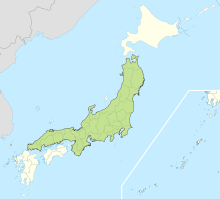Yamatai Honshu Theory


The Yamatai Honshu Theory is the theory that the Yamatai kingdom was located in Honshu, specifically Kinai, where the capital was located in the Kofun period rather than in Kyushu as the Yamatai Kyushu Theory proposes.[1]
According to this theory, the Yamatai was essentially continuous with the Yamato Kingship, with its capital in roughly the same region, and the Yamatai transformed into the Yamato Kingship when the Kofun period began[2]
Overview[edit]
Arai Shiraishi, in his "Koshitong or Inquires," proposed the theory of Yamato Province. Later, however, in "Gaikoku no Jijo Chosho" (Foreign Affairs Chronicle), he proposed the theory of Yamato-gun in Chikugo Province. Since then, from the Edo period to the present, the mainstream of the academic world has been largely divided between the "Honshu theory" (Naito Konan et al.) and the "Kyushu Theory" (Shiratori Kokichi et al.). The Kyushu theory, however, is divided into two distinct theories: one that says the Yamataikoku "moved" (the "eastward shift" theory) and one that says it "did not move at all. The "eastward shift" theory holds that the Yamataikoku moved to the Kinai region and became the Yamato Kingdom.[citation needed]
Masao Kume proposes the Two dynasties parallel theory (二王朝並立論) and states that the Queen Country (女王国) of More than 2,000 miles from the county to the Kingdom of Women (自郡至女王国萬二千餘里) is different from the Yamatai Kingdom (邪馬台国) of Thirty days by sea (海路三十日) ( 20 days of water travel from South to Touma (南至投馬国水行二十日) and Ten days of water travel from the south to the land of Yamatai (南至邪馬台国水行十日) and the female kingdom in Tsukushi is in Kinai through the "Civil War of Wa (倭国大乱)". It is assumed that the new royal capital, which was the capital of Japan, is Yamatai[3]
In the 1960s, it was thought that artifacts from the period of the Yamataikoku were abundant in Kyushu while those from the Kinai region were scarce in the Kinai region. The National Institute for Radiocarbon Dating and Dendrochronology has presented a chronology based on radiocarbon dating and dendrochronology that compares the tombs of Himiko and the Yamato imperial court to those of Yamatai and Himiko, and that the establishment of the Yamato Imperial Court dates back to that time. Some have suggested that radiocarbon dating of pottery from the Kinai region by the National Institute of Japanese Archaeology and Dating suggests that the establishment of the early state in the Yamato region of the Kinai region dates back to the same period as the Yamataikoku.[4][5][6][a]。. According to this Kinai theory, there was at least one power in 3rd century Japan that was able to secure transportation routes from Yamato to the continent, and it can be said that a power with great influence over the entire western Japan centering on Yamato, namely the "Yamato Kingdom," was already established at this time.[citation needed]
Makimuku ruins[edit]
The Makimuku ruins site is considered by some researchers to be the best candidate for the center of the Yamatai, and may be the site that proves the Yamatai Honshu Theory. In 2011, a part of another large building was found about 5 meters to the east of the large building ruins, and the building ruins may have been built in the late 3rd century or later.[7]。
Hashihaka Kofun[edit]

The Hashihaka kofun ( 箸墓古墳 ) is a megalithic tomb (kofun) located in Sakurai City, Nara Prefecture, Japan. The Hashihaka kofun is considered to be the first large keyhole-shaped kofun constructed in Japan and is associated with the emergence of the Yamato Kingship.[8] It is sometimes considered the birthplace of the Kofun system of tombs which is highly linked to the emergence of a state level society.[9][b]
See also[edit]
Annotations[edit]
- ^ This is because, in principle, dendrochronology can only determine the upper limit of the age of a monument, the number of experts is small, and the standard dendrochronological curve in Japan was created by a single research group, which does not even publish accurate data and does not allow for follow-up verification. It has also been pointed out that radiocarbon dating does not allow for follow-up verification because taking measurement data can damage artifacts and requires equipment.
- ^ Satoshi Ohira argues that although Tsuide's theory is supported insofar as it explains the establishment of the political system represented by the anterior-posterior mound and its continuous development, he does not necessarily agree with the theory that the difference in size indicates a relationship of domination and subordination between the chiefs throughout the country. The fact that they had to share the same tomb type, even though they were superior in size, should be taken into consideration, and should be regarded as a coalition or alliance rather than a domination relationship.[10]
References[edit]
- ^ "Yamatai | ancient kingdom, Japan | Britannica". www.britannica.com. Retrieved 2022-06-16.
- ^ "Yamatai | ancient kingdom, Japan | Britannica". www.britannica.com. Retrieved 2022-06-16.
- ^ (Masao Kume, "New Yamataikoku Theory: The Queen's Onimichi and the War of Conquest," Rekishi ni okeru Seiji to Minzoku (Politics and the People in History), 1986; "The Seal of the Emperor of Japan Wei and Its Historical Background," Studies in the History of Japanese Seals, Yusankaku, 2004).
- ^ 石野, 博信 (2008). 邪馬台国の候補地・纒向遺跡. Shinsensha. ISBN 978-4-7877-0931-8. OCLC 675187978.
- ^ 伊藤和史. "毎日新聞連載「深読み日本史 邪馬台国」". 邪馬台国の会. Retrieved 2011-11-12.
- ^ "「九州説は無理…」新井白石以来の邪馬台国論争ゴール近し 纒向遺跡". Sankei Shimbun. 2009-11-11. Archived from the original on 2009-11-14. Retrieved 2011-11-12.
- ^ 2011年4月28日産経新聞関西「大和政権の重要施設か、纒向遺跡で新たな大型建物跡」 2019年8月14日archive差し替え・閲覧
- ^ Brown, Delmer M. (1993). The Cambridge History of Japan, Volume 1: Ancient Japan. Cambridge University Press. p. 114. ISBN 0-521-22352-0.
- ^ 都出比呂志 (1991). "日本古代国家形成論序説-前方後円墳体制論の提唱-". 日本史研究. Vol. 343.
- ^ 世襲王権の成立 [Establishment of hereditary kingship]. ISBN 4-642-00802-0.
